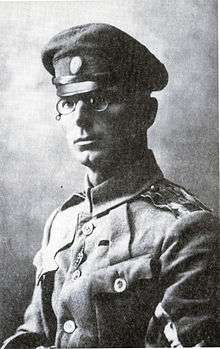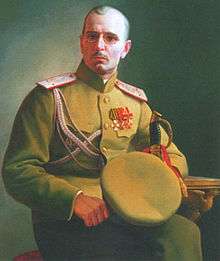Mikhail Drozdovsky
Mikhail Gordeevich Drozdovsky (Russian: Михаил Гордеевич Дроздовский) (October 7, 1881 – January 1, 1919) was a Russian army officer and one of the military leaders of the anti-Bolshevik White movement during the Russian Civil War of 1917-1923.
Mikhail Gordeevich Drozdovsky | |
|---|---|
 General Mikhail Drozdovsky | |
| Born | October 7, 1881 Kiev, Russian Empire |
| Died | January 1, 1919 (aged 37) Rostov-on-Don, Russia |
| Allegiance | |
| Service/ | |
| Years of service | 1899-1917 Imperial Russian Army 1917-1919 White Army |
| Rank | General |
| Battles/wars | Russo-Japanese war World War I Russian Civil War |

Biography
Drozdovsky was born in Kiev where his father was a highly decorated general of the Crimean War. His mother died when he was twelve, and he was largely raised by his elder sister, Julia, who was a decorated nurse during the Russo-Japanese War.
He started his military career early in life, entering the Polotsk Cadet Corps in 1892, and subsequently transferring to the Vladimir of Kiev Cadet Corps, from which he graduated in 1899. In August 1899, he enrolled in the Pavlovsk Military School in St. Petersburg, famous for its strict discipline and considered a model in the training officers of the Imperial Russian Army. He graduated in 1901 at the top of his class.
From 1901, Drozdovsky served in the Life Guards Regiment in Warsaw and was promoted to lieutenant in 1904. With the Start of the Russo-Japanese War he was sent to the front lines with the 1st Siberian Corps of the 2nd Russian Manchurian Army. He was wounded in the thigh during the Battle of Sandepu, but remained on the front lines through the end of the conflict and was awarded with several decorations for heroism.
After the end of the war, Drozdovsky completed his studies at the General Staff Academy in 1908 and was promoted to Stabskapitän, and to captain in 1910. He was stationed at the Headquarters of the Amur Military District in Harbin, Manchuria. In November 1911, he was appointed Assistant to the Senior Staff of the Warsaw Military District. With the start of the First Balkan War in October 1912, he volunteered for combat duty, but his application declined. Instead, he was assigned to the Sevastopol Aviation School, where he became a pilot and trained on aerial reconnaissance. He also trained with the Imperial Russian Navy, taking a dive in a submarine, and also diving using a diving suit. After this training, he returned to the Warsaw Military District.
At the start of World War I, Drozdovsky served as a staff officer for the Russian 27th Army Corps on the Northwestern Front. He made a number of reconnaissance missions using an airplane and a balloon. From December 1914, he was assigned to the headquarters of the 26th Army Corps. He was promoted to lieutenant colonel in March 1915, and became Chief of Staff of the 64th Infantry Division in May 1915. He led his division from the front in numerous battles to the end of 1915. From October 1915, he was chief of staff of the 26th Army Corps. From the summer of 1916, he was on the General Staff as a colonel, serving on the Southwestern Front. Wounded in the hand during a battle on August 31, 1916, he was awarded the Order of St. George (4th class).
However, with the February Revolution, Drozdovsky was faced with collapse of central authority. Known as a staunch monarchist, he refused to acknowledge the formation of committees of enlisted men which challenged the authority of (and often murdered) their superior officers. He suppressed Bolshevik elements within his command through executions, and managed to maintain discipline and order, and continued combat operations against the Germans until late August 1917. However, with the Bolshevik seizure of power in the October Revolution and separate peace with Germany, Drozdovsky was forced to resign his commission. He refused offers of a position as commander of an infantry division in late November, and instead contacted General Mikhail Alekseev, who had started an anti-Bolshevik uprising in the Don region. Drozdovsky promised to form a unit of volunteers from troops at the Romanian front and join the White movement. In January 1918 "White Guard" volunteer units were created in Kishinev, and Iaşi in Romania, as well as in Bolgrad in the Odessa region. Colonel Drozdovsky decided to lead his anti-Bolshevik forces east and join the Volunteer Army in its fight against the Red Army in the Don region of southern Russia.
On February 26, 1918, despite the actions of the Romanian army, which tried to disarm them, Drozdovsky and his men, numbering around 1100 war veterans (most of them officers), started their march to the Don. On its way Drozdovsky was joined by other officers and soldiers hostile to the new Soviet regime. Drozdovsky's private notes written during the march show him as a patriotic officer who felt that he had no choice but to fight the Bolsheviks—whom he considered the destroyers of Russia. The notes often reveal a sense of doomed resignation. This, however, did not prevent him from acting with great energy and from being an inspiration to his men. On April 21, 1918, Drozdovsky briefly captured Rostov-on-Don. While battling for Rostov's train station, Colonel Voinalovich, Drozdovsky's second-in-command and closest advisor, was killed in action. Three days later, Drozdovsky's force came to the assistance of the Don Cossacks desperately battling Red forces at Novocherkassk. The Reds were defeated and Drozdovsky's men marched into Novocherkassk. It is here, after a 900-mile march from Romania to the Don, that Drozdovsky and his men officially became part of the Volunteer Army.
In June 1918, at the start of the Second Kuban Campaign, General Anton Denikin promoted Drozdovsky to the rank of Major General, and his unit, now augmented with an influx of new volunteers, was designated as the 3rd Infantry Division. Drozdovsky's unit became one of the elite formations of the Volunteer Army (later called the Armed Forces of South Russia). Drozdovsky was one of the firsts among the White Army commanders to augment his forces with Red Army prisoners they captured in battle. Although the initial performance of these former Red Army troops exceeded Drozdovsky's expectations, as their numbers increased their reliability decreased.
General Drozdovsky was wounded in October 1918, during a battle near Stavropol. Although initially it was thought that the wound was not serious, he never recovered and died on January 1, 1919, in the vicinity of Rostov-on-Don. Subsequently the 3rd Infantry Division, which consisted of several regiments, became known as the Drozdovsky Rifle Division, one of the famous "colored" units of the Volunteer Army. The Drozdovsky Division was well known for its fighting spirit and esprit de corps. In 1920, before the departure of the Volunteer Army from Crimea, General Drozdovsky's remains were secretly reburied by his men in Sevastopol, Crimea, to prevent their defilement by the Bolsheviks (as happened with the remains of General Lavr Kornilov). Their exact location remains unknown to this day.
Honors
.png)
.png)
.png)



- Gold Sword for Bravery